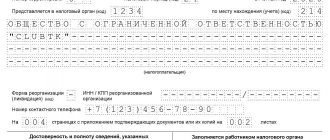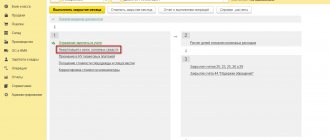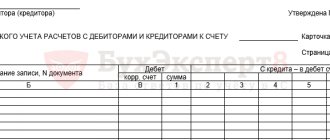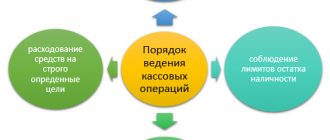- general information
- Features for paid and free users
- Login to VAT+
- Requirements for files to be uploaded
- Uploading documents to the service
- Reconciliation results
- Editing invoices in VAT+
- Directory of counterparties
- Deductions
- Setting up notifications
Since 2015, as part of the VAT return, it is necessary to transfer information from purchase and sales books, as well as invoice journals.
Tax authorities will compare the data of buyers and sellers. If discrepancies are found in the data, the inspectorates will send requests for clarification. It is recommended to check with your counterparties before submitting your VAT return. In the Kontur.Extern system there is no way to check with counterparties; a separate service has been developed for this - Kontur.VAT+.
There are several types of users in Kontur.VAT+:
- Free user - a user who has received an invitation to the service from his counterparty (see detailed instructions for free users).
- Free user (Kontur.Extern subscriber) is a Kontur.Extern user. All Kontur.Extern users have access to VAT+, in which they can only check against the sales book.
- Paid user - a user who purchased Kontur.VAT+. Divided into 3 tariffs: Maximum, Standard, Minimum.
What features are available to different types of users:
| Paid user on the “Standard” tariff | User Contour.Extern | Free user |
|
|
|
| Paid user on the “Minimum” tariff | Paid user on the “Maximum” tariff | |
|
| |
To connect the full-featured version of Kontur.VAT+, contact the service center. If you need to connect organizations for service to Kontur.VAT+, you should also contact the service center.
Login to VAT+
You can log into the service using any browser at https://nds.kontur.ru. Login is carried out using a login/password or a certificate. To switch to Kontur.VAT+ from the Kontur.Extern system, use the menu “Kontour” > “VAT+”.
You can also go to Kontur.VAT+ from Kontur.Extern from the page for working with the VAT form.
Login using a certificate
After logging in to https://nds.kontur.ru, an authorization window will appear, select the desired certificate and click “Login”. To log in, you can only use those certificates that were received at SKB Kontur for working in the Kontur.Extern system.
Login using login and password
After logging in at https://nds.kontur.ru, an authorization window will appear, enter the required login (email) and password, and then click “Login.”
Work in the service
Working with service organizations
The service has the opportunity to work with organizations for maintenance; this opportunity is paid separately. To add organizations, you must contact the service center. If organizations have already been added to the service, a list of companies will appear when you log in. To get started, select the desired organization from the list.
Requirements for files to be uploaded
You can upload to the service both individual files of information from purchase books, sales books and invoice journals, as well as entire VAT declarations with attachments. You can upload files in the following formats:
- Xml files of information from sales and purchase books.
- Xml files of information from the logs of received and issued invoices.
- Xml and Xls files additional. sheets of sales and purchase books.
- Xls files of purchase / sales books.
- Xls log files of issued and received invoices.
- Zip archive with information files and a declaration in Xml format, or books with a declaration in Xls format (the file format in the archive must be one, not mixed).
Examples of excel files
Uploading documents to the service
When you first log into Kontur.VAT+, a button will appear to upload a declaration or individual books for reconciliation.
To load or view data for a different period, change it in the upper left corner.
To download a declaration, a book of purchases/sales, a journal of invoices, click the “Download” button and specify the type of file to download - a book of purchases/sales, a declaration or a directory of counterparties. If Kontur.VAT+ is not paid, but Kontur.Extern is connected, then only one item “Sales Book” will be available for downloading documents.
In the window that opens, select the files that need to be downloaded.
Immediately after selecting the files, downloading and automatic verification will begin. If you select Excel files of the purchase/sales book in xls, xlsx or csv format, they will be automatically converted to xml format and will be loaded into Kontur.VAT+. Similarly, upload all the documents that need to be verified.
Reconciliation results
Reconciliation occurs automatically; the results of reconciliation for all uploaded documents appear on the main page of the service and are divided into categories:
Errors in the declaration
When comparing invoices, logical control errors were discovered, in the presence of which the tax authority will not accept the declaration.
Control Ratio Warnings
When uploading documents to the service, inconsistencies were identified in the control ratios (for example, in sections 1-7 or 8-12 of the VAT return).
Book of purchases
With discrepancies – when comparing invoices (specified in the purchase book) of the user and his counterparties, discrepancies in the invoice data (for example, in the amount) were detected.
No discrepancies – reconciliation with counterparty data was successful, there are no discrepancies.
Sales book
With discrepancies – when comparing invoices (specified in the purchase book) of the user and his counterparties, discrepancies in the invoice data (for example, in the amount) were detected.
No discrepancies – reconciliation with counterparty data was successful, there are no discrepancies.
Warnings regarding the contents of the declaration
When comparing invoices, non-critical logical control declarations were discovered and recommended for correction.
Counterparties
Not yet verified - counterparties who have not uploaded their documents to the service in the selected quarter.
May be invited - these companies are not yet registered in Kontur.VAT+, they must be invited.
Why do we need VAT reconciliation reports?
In theory, all organizations should constantly reconcile data regarding VAT. Each copy of the invoice must have its own “double” with the second participant in a particular transaction. The future electronic database will help tax authorities track not only the presence of a second participant in each transaction, but also its value. Of course, in the event of any discrepancy in the amount of invoices, the tax office will require clarification from each participant in the transaction. In accordance with current legislation, organizations have only 5 days to satisfy the tax authorities’ request. That is, in such a short period of time, the accounting department of one company must contact the accounting department of the second company, come to a consensus who is right and agree on how exactly they will justify the discrepancies found in the tax office. It is worth noting that if the explanations do not satisfy the inspector, the companies may be refused to pay VAT.
Above we looked at a situation where there is a pair of invoices, but the data in them does not match. If there is no second pair at all, then the consequences for the organization can be much more serious. In addition to refusing to pay VAT, the tax office may impose fines and penalties on the company.
To avoid such situations, we recommend that you perform a VAT reconciliation. This can be done manually, however, it will require a lot of time and personnel resources. You can also automate the procedure and do it in special software. For example, the VLSI Electronic Reporting product has this functionality. To work with it, you will need an electronic signature, which can be purchased on the website of our EDS Center.
Control Ratio Warnings
This category displays the number of errors in the control ratios in the uploaded declaration.
To view discrepancy details, click on a category.
To view the numbers from the declaration, open the “Section Contents” item. In Kontur.VAT+ it is impossible to correct data from the declaration. Errors and warnings must be corrected in the program in which the declaration was filled out.
With discrepancies (purchase book/sales book)
Transactions in which discrepancies were found in your data and in the data of your counterparties fall into this category.
Possible discrepancies:
- by the amount of VAT or the total value of the invoice;
- you or your counterparty do not have an invoice.
To go to a list of invoices with discrepancies, click on a category. If the transaction is reflected with the correct parameters, then you can remove the discrepancy using the “I have it correct” button. To transfer all invoices from the “Invoice with discrepancies” section to the “Invoice without discrepancies” section, click on the “All is correct” button and confirm the action.
When you click on the line with the document, a pivot table will appear, which will display your data and the data of the counterparty for the transaction.
The field in which a discrepancy is detected will be highlighted in red. It is necessary to find out on whose side the mistake was made. To communicate with the counterparty, you can use the chat, which is located to the right of the disagreement. If necessary, you can attach documents to the chat. When counterparties add new comments or documents to transactions with disagreements, information about them will appear in the message history on the main page of the service and will be sent as a notification to your email.
Errors must be corrected in the accounting system in which you keep your books and journals. The corrected document must be re-uploaded to Kontur.VAT+. You can also edit an invoice directly in Kontur.VAT+, to do this, click the “Edit” button. We recommend making changes to your accounting system. If the discrepancy is resolved, the number of transactions in the “With discrepancies ” will decrease.
How to check a VAT return in 1C
Published 10/18/2016 11:28
In this article I want to tell you a little about checking your VAT return. Of course, this is a complex and multifaceted process, which largely depends on the specifics of the organization’s activities and the composition of the operations performed. But, nevertheless, there are some basic techniques, without knowledge of which it will not be possible to understand the logic of filling out and checking this report. Now we will talk about one of these techniques, namely, reconciling the VAT return with information on account 68.02. We will consider an example based on 1C: Enterprise Accounting 8 edition 3.0, but the information provided is also relevant for other 1C version 8 programs.
So, in order to start checking, we need to open the completed VAT return and generate an “Account Analysis” report for account 68.02 for the tax period.
The “Credit” column of this report reflects the amount of calculated VAT, and the “Debit” column shows the amount of VAT claimed for deduction and transferred to the budget. We will check the “account analysis” with section 3 of the VAT return. Line 010 of Section 3 of the VAT return reflects the amounts of the tax base and the tax calculated on the sale of goods, works, and services at a rate of 18%. In our case, the organization carried out sales only at this rate, so the amount in line 010, in general, should coincide with the turnover of account 68.02 and account 90.03.
Also in the “Credit” column of the “Account Analysis” report we see the turnover on account 76.AB, i.e. VAT calculated on the amounts of advances received from buyers. Accordingly, we should see the same amount in the declaration on line 070. Now we check the tax deductions. The amount of VAT charged to our organization when purchasing goods, works, services is reflected in account 68.02 in correspondence with account 19, and in the declaration it falls on line 120.
The amount of VAT on offset advances from customers is displayed in the “Debit” column in correspondence with account 76.AB and in line 170 of section 3 of the VAT return.
I would like to draw your attention to several important points: - if during the tax period there were refunds of advances to buyers, then you must remember that the amounts of such refunds will be reflected on line 120 of section 3 of the VAT return, i.e. together with VAT on purchased values. Accordingly, when reconciling the declaration and analyzing account 68.02, there will be discrepancies by the same amount in turnover with accounts 19 and 76.AB (refund amounts will be reflected in correspondence with account 76.AB, but in the declaration they will appear in the line that we check with count 19). - if you want to check the total turnover in the debit and credit of account 68.02 with the total amounts of calculated VAT and VAT deductible on the declaration, then you need to remember that in the account analysis in the “Debit” column also reflects the amounts of paid VAT, which are not reflected in the declaration (turnover with a score of 51). — the final balance in account 68.02 will coincide with the amount of tax payable according to the declaration if there is no debt or overpayment for previous tax periods. Of course, the situation that we have considered is quite simple and illustrates only the basic principles of VAT verification. If VAT recovery operations, accounting at different tax rates or various returns are added, then the reconciliation becomes more complex and interesting. But I highly recommend checking the declaration with an analysis of account 68.02 for one simple reason: the declaration is filled out using information from the VAT tax registers, and the account analysis is performed according to the accounting entries. Unfortunately, in practice, I very often encounter discrepancies in these amounts, which are caused by errors in accounting, manual entries and adjustments. In this case, a simple reconciliation will help you find shortcomings, understand their causes and submit a correct VAT report. If you want more useful information about working with VAT, about filling out and checking the declaration in the 1C: Enterprise Accounting 8 program, and you would also like our written consultations on this topic, then we highly recommend our video course “VAT: from concept to declaration” , which has already helped a large number of accountants understand the calculation of this confusing tax. I wish you an easy reporting period and successful work in 1C programs!
Did you like the article? Subscribe to the newsletter for new materials
Our training courses and webinars
Reviews from our clients
>
Warnings regarding the contents of the declaration
This category includes transactions in which incorrect details of counterparties were indicated, if the counterparty is not registered in the Unified State Register of Real Estate, as well as transactions in which logical control errors were detected and recommended for correction. There can be multiple warnings on one invoice.
To go to a list of invoices with warnings, click on a category.
Possible reasons for warnings:
- The control ratio for TIN and/or checkpoint is not met;
- The counterparty is not registered in the Unified State Register of Real Estate;
- The invoice contains a negative value or tax amount;
- The invoice date in the sales book is not from the current tax period;
- An invoice with the number you specified was not found at the counterparty, but there is a similar one;
- Invoices for advance payments (quo 02, 05, 12) and invoices for sales (quo 01) must have different numbers.
To view the full text of the warning, hover your mouse over the line with the invoice and a tooltip will appear. Or click on the line and the invoice will open.
To correct the warnings, do one of the following:
- Edit the data directly in Contour.VAT+;
- Make changes to the book in the accounting system in which it was prepared. Then re-download information from purchase/sales books and invoice journals. Reconciliation will occur automatically, the counter of the “Warnings on the contents of the declaration” category will change.
Other tools for checking VAT
1C users also have other tools at their disposal to ensure control over the correctness of VAT calculation. To do this, you need to go to the “Reports” - “Accounting Analysis” section.
Below is the document “Express check of accounting”, which is available to users among the first. It includes several sections, including maintaining books of purchases and sales.
The main advantage of these tools is not only identifying errors, but also providing the user with recommendations for their further elimination. For example, in the example below, in the list of invoices there was a violation of the numbering order. You can eliminate the inaccuracy by starting a new automatic numbering of documents.
Below is an option with a list of sales documents that do not include invoice data. An extract of a missing invoice is carried out directly from the form, by entering the document of interest from the report.
An analysis identical in composition can be carried out in relation to VAT claimed for reimbursement. As an example, a case is shown where discrepancies occurred in the reflection of data on account 19.
The document “Analysis of VAT Accounting” reflects the final data on the amount of accrued VAT and the amount of deductions made. Moreover, each of the numbers is available for decoding, right up to the creation of primary documents.
Haven't checked yet
Counterparties in this category have already received invitations to the Kontur.VAT+ service, but have not yet uploaded their documents in the selected quarter.
To invite these counterparties to VAT+ again, click on the link of the same name. All companies on the list will receive an invitation to the previously specified e-mail addresses. At the moment, it is possible to automatically re-invite up to 200 companies. If there are more than 200 companies in the list of counterparties, then repeat invitations must be sent manually.
May be invited
This section displays counterparties that are not yet registered for VAT+ and cannot check with their counterparties. To invite these counterparties to the service, click on the “Specify email and send an invitation” link.
The list is initially generated for the selected period. To see counterparties for all periods, you need to check the box “Show counterparties for all periods”
In the list that opens, click on the “No email” link next to the desired organization.
In the “Invitation” item, select “Specify email and send an invitation.”
Enter your email address and click on the “Save” link.
In addition, you can download a directory of counterparties for sending mass invitations.
What is the 1C:Sverka service?
Why is the 1C:Sverka service needed?
1C:Sverka is a service that performs prompt reconciliation of invoice data from suppliers registered in our database with invoices registered in the supplier database.
How to connect the 1C:Sverka service?
To use the 1C:Sverka , you must connect the program to Internet support.
1C: Reconciliation in the program
1C: Reconciliation service in the program is implemented in the form of a special processing, which is launched through the section Sales - Settlements with counterparties - Reconciliation of VAT accounting data or Purchases - Settlements with counterparties - Reconciliation of VAT accounting data.
Setting up an email account
When the service operates, data exchange occurs via email. Before you start working with the service using the link Processing settings Reconciliation of VAT accounting data, you need to check the settings of the account that will be used to receive and send email messages.
In the account card for receiving and sending email messages, check the following boxes:
- To send letters;
- To receive letters.
On the Sending emails and Receiving emails of your account card, you need to check the following fields:
- Email address – enter the organization’s email address;
- Password —enter the password for the organization’s email address.
For more information about setting up an account, see the article Setting up an account.
Editing invoices
In addition to correcting discrepancies in your accounting system, you can edit your invoice in the VAT+ service. To do this, find the invoice you need, open it and click the “Edit” button in the lower left corner. Make the necessary changes and click the “Save” button.
To download edited books from Kontur.VAT+, click the “Upload” > “Declaration” > “Upload to Computer” button.
In the window that opens, select the required partitions and click on the “Upload” button. The uploaded files can be uploaded to Kontur.Extern for sending to the Federal Tax Service.
Correct mistakes
Click the discrepancy amount. In the window that opens, the data is divided into two blocks: on the left - invoices in your report, on the right - in the counterparty’s report. Inconsistencies are highlighted in red.
Open the discrepancy to see the cause.
If the problem is on your side
— go to the invoice and make changes or add a missing entry.
If the counterparty made a mistake
, contact him by phone or directly from VLSI in one of the following ways:
- Hover over the discrepancy and click to send a message or to start a video call;
- at the divergence, press . Select "Message" to send a message, or "<Account Name>" for a video call. You can attach scans of documents or xml files to your message.
To view your correspondence history, go to the “Feed” tab.
Counterparties with the statuses “Not in the system”, “Reports not ready” and “Errors in the counterparty” cannot be called from VLSI.
The reconciliation results are updated in real time: if the counterparty changes something in the declaration or starts a reconciliation, you will see it in the results table.
Once all discrepancies have been corrected, submit a report to the tax office.
Switch between sections
To switch between sections, use the top menu in the “Declaration” item. Red dots mean that the data of the specified partition has been loaded into the service. The absence of red dots means that there is no data in the service.
Any list for any loaded section can be downloaded from the service. To do this, click on the “Save” button on the desired section.
Specify the format of the uploaded file and click “Save to Computer.”
If you upload a VAT declaration to the service along with books and magazines, the data from it will be displayed in the “Declaration” section. Data from the declaration (sections 1-7) are available for viewing only and cannot be edited. It is allowed to download xml files of VAT declarations in the format approved by Order of the Federal Tax Service dated October 29, 2014 No. ММВ-7-3/ [email protected]
The “Help” section contains recommendations from SKB Kontur experts on working with discrepancies, requirements, composite invoices, additional sheets in 1C, warnings on invoices, and also describes the procedure for using the transaction type code.
Why do you need to check your VAT return?
It is imperative to check the VAT return before submitting it to the Federal Tax Service in order to exclude errors in it and avoid submitting clarifications due to inconsistencies in the data.
How to check your VAT return? The Tax Service has established control ratios (hereinafter referred to as CS), according to which inspectors carry out their verification, to facilitate this procedure in the Federal Tax Service. However, taxpayers can also use the CC. They can be found in the letter of the Federal Tax Service dated March 23, 2015 No. GD-4-3/ [email protected]
Note! The VAT return was updated by order of the Federal Tax Service dated August 19, 2020 No. ED-7-3/ [email protected] The form is used from the reporting campaign for 2021.
You will find a line-by-line algorithm with examples of filling out all twelve sections of the report in ConsultantPlus. Trial full access to the system can be obtained for free.
The formulas contained in the CS allow you to compare the indicators entered in sections 1–7, both within these sections and between them, and in conjunction with data from sections 8–12. For the convenience of users, all KS are presented in the letter of the Federal Tax Service in question in the form of a table.
In addition to the formulas, the tabular part also contains information about how the inspector will qualify the detected violation and what his actions will be.
However, checking the VAT return according to the Tax Code is the final stage of the verification. Therefore, before applying the CS, the taxpayer should check the accounting records. How to check a VAT return based on turnover or other accounting registers? Data from these registers should give the figures that will appear in the declaration:
- for accounts 90, 91 - in terms of sales volume for each tax rate;
- accounts 60, 62, 76 - in relation to the correspondence of the amounts of advances and VAT related to them;
- for account 19 - according to the amounts of deductions;
- account 68 - in terms of accounting for all VAT amounts involved in the calculation and forming the final result of the declaration.
Let's look at how to check a VAT return on turnover using an example.
Example.
The accountant of Smiley LLC filled out a VAT return and, before sending it to the Federal Tax Service, decided to reconcile the data with accounting (the rate of incoming and outgoing VAT is 20%).
To do this, he generated an analysis of account 68 VAT subaccount.
He also checked the speed by:
- Dt 62.1 x 20: 120 = Dt 90.3 = line 010 section 3;
- Kt 62.2 x 20: 120 = Dt 76 AB = line 070 section 3;
- Dt 62.2 x 20: 120 = Kt 76 AB = page 170 section 3;
- Kt 60 x 20: 120 = Dt 19.03 = page 120 section 3.
The accountant also verified the sales adjustment reflected in the VAT return, because an adjustment invoice was issued for the increase. The accountant recorded this information in pp. 040-090 section 9.
Find out how tax authorities correlate the indicators of each line of the VAT return with each other in the Ready-made solution from ConsultantPlus. If you do not have access to the K+ system, get a trial online access for free.
Counterparties
The list of all counterparties, transactions with which are reflected in documents uploaded to the service in the selected quarter, is located on the “Counterparties” tab.
Using the “Download” > “Directory” button, you can download a pre-prepared list of counterparties in Excel format.
Required fields are “TIN” and “KPP”. The fields “Name of organization” and “Full name of contact person” are optional.
The reference book must be prepared according to the following template:
To send an invitation for reconciliation, you must go to the “Invitations” section, click on the line with the counterparty (but not the name), indicate the email address, and click on the “Save” button.
If for some reason the counterparty did not receive the invitation, then you need to select the required counterparties and click on the “Resend invitation” button.
The directory of counterparties contains a color indicator next to each counterparty. When you click on it, a short company card from the Kontur.Focus service appears.
The color indicator indicates the degree of reliability of the company:
- Green (positive facts) - not a single suspicious fact was found about the company;
- Yellow (important facts) – suspicious facts have been discovered about the company;
- Red (critical facts) - the company is liquidated or in the process of liquidation;
- White (the company is not in Kontur.Focus) - most often this happens with foreign companies, or if the TIN of the counterparty is incorrectly indicated in the uploaded book.
The company card also indicates statistics of transactions with a given counterparty, the status of document loading, information about contact persons, invitations and those responsible for reconciliation with the selected organization.
When you click on the company name in the list, invoices with this counterparty in the selected period appear.
In the list of counterparties, it is possible to assign employees responsible for reconciliation with specific counterparties. Additional workstations (possibility of adding responsible employees) are purchased separately. To assign responsibility, select one or more counterparties and click the “Assign Responsible” button.
In the window that appears, indicate the responsible employee from the list, or add a new one using the “Add employee” button.
When adding an employee, provide their first and last name, as well as their email address. A letter will be sent to the specified address notifying the employee that he has been appointed responsible for reconciliations with certain counterparties.
In addition, you can assign a person responsible for reconciliation with the entire organization. To do this, go to the list of organizations by clicking on the name of the current organization at the top of the page. Click on the “No responsible person” link under the desired organization (or on the link with the full name of the current responsible person).
Specify the responsible employee from the list or add a new one.
The responsible employee will be able to work in the service and log in using the email that was specified for him. When logging in, he will only be able to see those organizations for which he has been assigned responsibility.
The “Summary” tab of the “Counterparties” section displays summary information for all counterparties for the selected period. If you wish, you can see all the contractors, Fr.
The “Summary” displays the latest changes in the “Traffic Light” status of counterparties, the TOP organizations by the amount and number of invoices with discrepancies, information on invitations, as well as the percentage of counterparties by “Traffic Light” status.
The TOP discrepancies in the amount of VAT and the number of invoices show 5 organizations with the highest indicators. If you click on “See all”, a list will open, arranged in descending order by the corresponding indicator.
The “Invitation from counterparties” column shows how many invitations have been sent, read and accepted. By clicking on the number of counterparties, the corresponding list of companies will open.
“Last changes” shows the last 5 contractors whose status in the “Traffic Light” service has changed. Clicking on “View All” will open “Monitoring”.
“Monitoring” shows all contractors whose status in “Traffic Light” has changed. The information is broken down by date of modification.
Reconciliation of VAT accounting data
Home / Services / 1C support and maintenance / 1C: Support Kit (1C: ITS)
The 1C:Reconciliation service provides automatic reconciliation of invoices with suppliers and customers at any time convenient for the user - both promptly during the accounting process and before sending a VAT return to the Federal Tax Service.
Service capabilities:
- requesting information about issued invoices from suppliers and automatically loading them into the 1C program;
- automatic comparison of invoices of counterparties and your organization;
- managing the provision of information about received invoices to customers in response to requests received from them;
- convenient reports with reconciliation results - with visual highlighting of discrepancies and the ability to decipher them back to the original document.
Advantages
- the service allows you to organize regular prompt reconciliation of invoices without waiting for the end of the reporting period;
- support for general reconciliation with all counterparties immediately before generating a declaration and sending it to the Federal Tax Service;
- reconciliation is performed directly in the program - without the need to upload and download data that is a trade secret to third-party applications or third-party sites;
- for each identified discrepancy, you can immediately go to the source document for study and correction, if the source document is included in the 1C information base;
- the user can plan his work in a way that is convenient for him and his partners, so as not to leave the analysis of complex situations until the last days before the deadline for submitting the VAT return.
The main changes in the form and procedure for submitting a VAT tax return are aimed at ensuring that the tax service can automatically compare information about the transactions of counterparties, monitor and identify organizations that have understated their tax liabilities. For this purpose, the Federal Tax Service, as part of its internal desk control, carries out a total automatic reconciliation of data from the purchase and sales books of all taxpayers. The possibility of a similar preliminary check for taxpayers is implemented in the 1C:Sverka service.
The Vendor Invoice Reconciliation report compares your database data with your vendor data. The compliance of invoices is checked using three parameters: number, date, amount.
The report is located in the “Purchases” – “Reconciliation of VAT accounting data” section. It can be generated either for one counterparty or for all of them for which you have loaded data into the database. Lines with discrepancies are displayed twice in the report - “according to our data” and “according to the supplier” and are highlighted in red. There are 4 possible results of reconciliation:
- the data matches
- an invoice with the same number and dates is not in the counterparty’s database
- the counterparty does not have an invoice with such numbers and dates
- The data differ in amounts.
How to load supplier data into the database?
Supplier data in the buyer's database is stored as documents "Registers of supplier invoices" in the section "Purchases" - "Reconciliation of VAT accounting data". You can download them either using the “Download” button, specifying the path to the corresponding .xml file, or from e-mail to all contractors who sent the registers. To be able to download or send registers via email, you need to set up an email account in the program.
How to upload data to the buyer?
As a supplier, you can send reconciliation data to the buyer. To do this, you need to generate a report “Register of issued invoices” , which is located in the “Sales” - “VAT Reports” section.
This report can be downloaded using the appropriate button or sent to the buyer by email directly from the form.
To send by email, you must set up an email account. Its settings are located in the “Administration” - “Organizer” - “System email account setup” section.
Specify the settings for outgoing and incoming mail servers. If you already have an account in the program, check whether the ability to receive email is enabled.
You can get more detailed advice: 8 – Consultations on Electronic reporting 8 – Technical support 8 – Consultations on 1C: Salary 8 – Consultations on 1C: Accounting
Deductions
Deductions are amounts by which a taxpayer can reduce the tax assessed for payment to the budget. In most cases, this is the VAT that the buyer has already paid to suppliers in the chain of transactions. To receive a deduction, companies submit to the Federal Tax Service the Purchase Book (Section 8 of the declaration) with invoices received from suppliers.
Information on deductions can be viewed for the 4 most important time periods.







